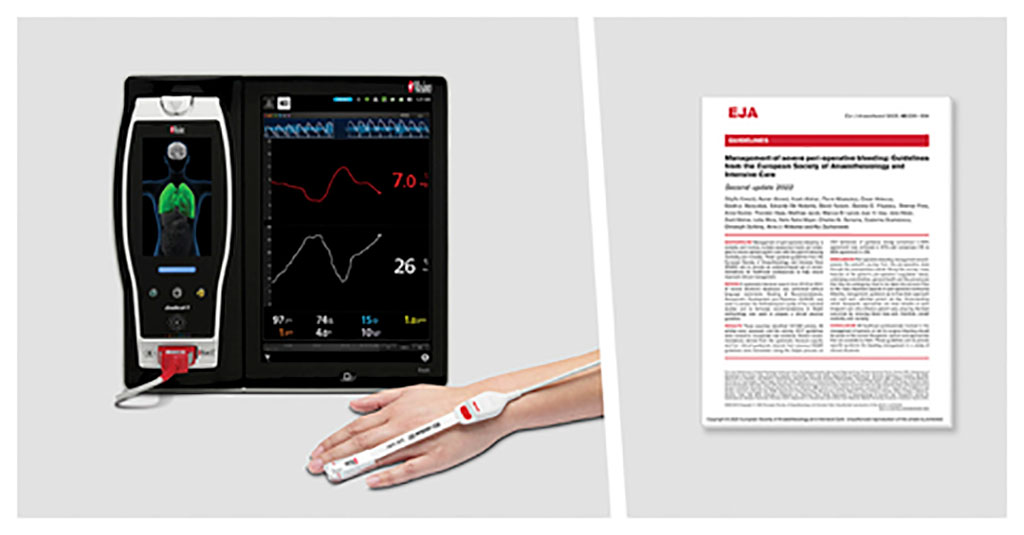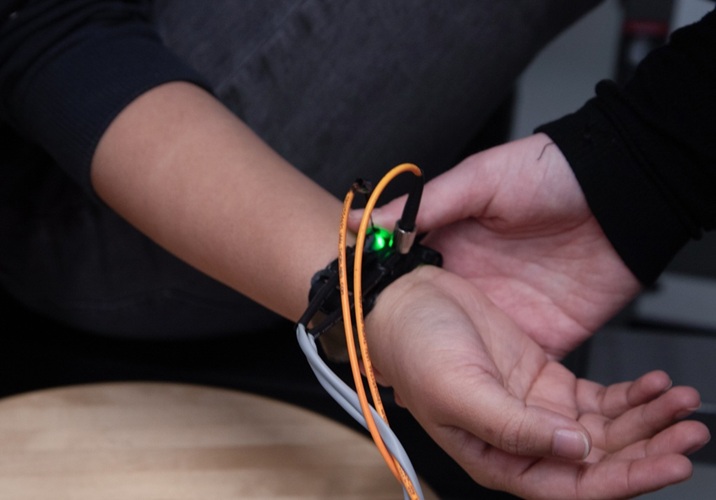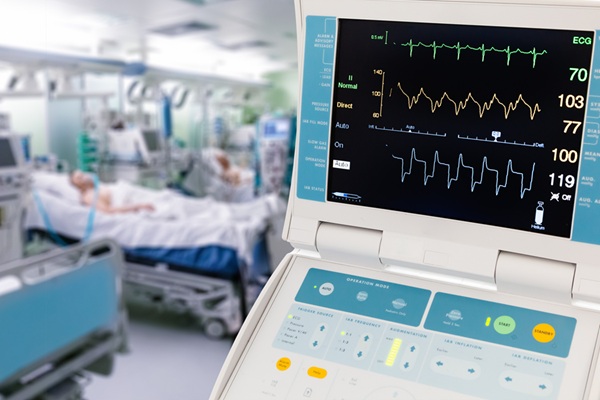Noninvasive, Continuous Hemoglobin Monitoring Helps Clinicians Better Manage Perioperative Bleeding
|
By HospiMedica International staff writers Posted on 21 Mar 2023 |

The European Society of Anesthesiology and Intensive Care (ESAIC, Brussels, Belgium) has updated its guidelines for perioperative blood management that emphasize the significance of noninvasive, continuous hemoglobin (Hb) monitoring in helping clinicians manage perioperative bleeding. Referencing studies using technologies such as Masimo SpHb from Masimo (Irvine, CA, USA), the guidelines note that “the use of noninvasive Hb-monitoring methods may be a practical approach to monitor[ing] the Hb concentration continuously and without accumulating additional blood losses.”
The ESAIC which revisits its perioperative blood management guidelines once every five years has published its updated findings based on its systematic review of research published from 2015 to 2021. Noting that managing bleeding during surgery is complex and “involves multiple assessment tools and strategies to ensure optimal patient care,” the guidelines cover various modalities, disciplines, scenarios, and patient populations – including how noninvasive, continuous hemoglobin monitoring can significantly improve blood management.
The ESAIC’s updated guidelines point to a major drawback in using blood gas analyzers and invasive blood sampling to measure hemoglobin during surgery: “single measurements taken at different time points may not depict accurate values.” They also note that excess blood sampling can result in iatrogenic blood loss and hospital-acquired anemia. Noninvasive hemoglobin monitoring cannot replace invasive blood sampling, but provides a “practical approach to monitor[ing] the Hb concentration continuously and without accumulating additional blood losses.” The guidelines also note its importance “for trend analysis and to monitor changes in addition to laboratory-measured Hb concentrations during the intervals between invasive blood sampling and Hb measurements.” The guidelines continue, “Having access to continuous measurements of Hb concentrations offers timely detection of changes in Hb concentrations and adjustment, if necessary, in the clinical setting.” Additionally, the guidelines note that when severe bleeding and volume shifts are expected or occurring, “continuous noninvasive hemoglobin monitoring may be considered for trend analyses and for reducing blood sampling for invasive laboratory measurement of hemoglobin concentration, especially in children.”
The Masimo SpHb uses multiple wavelengths of light to continuously monitor changes in the hemoglobin trend between invasive blood samples in real-time. This advanced technology has proven beneficial in patient blood management programs, enhancing outcomes in both high- and low-blood loss surgeries such as decreasing the number of patients requiring allogeneic transfusions, reducing the total units of red blood cells transfused per patient, and decreasing the time to transfusion, reducing costs, and lowering patient mortality within 30 and 90 days after surgery by 33% and 29%, respectively when combined with a goal-directed fluid therapy algorithm using Masimo PVi.
“Noninvasive hemoglobin measurements now represent standard of care in many clinical scenarios,” said Professor Kai Zacharowski, past President of ESAIC and senior author of the guidelines. “With their inclusion in the latest perioperative bleeding guidelines, we hope that more anesthesiologists around the world incorporate this technology into their daily practice to help improve overall patient blood management.”
“With laboratory measurements, and even with bedside point-of-care hemoglobin testing, results are intermittent, sampling errors can occur, and performing these tests can be distracting during complex cases and while caring for critically ill patients,” added Dr. William C. Wilson, Chief Medical Officer, Masimo. “SpHb monitoring provides real-time visibility to hemoglobin levels throughout the continuum of care and has the advantages of trend analysis as well as reductions in workload and delay, enabling clinicians to adjust blood management and observe results simultaneously.”
Latest Surgical Techniques News
- Breakthrough Polymer Significantly Improves Safety of Implantable Medical Devices
- First-Ever Technology Makes Blood Translucent During Surgery
- Tibia Nailing System with Novel Side-Specific Nails to Revolutionize Fracture Surgery
- New Imaging Probe to Transform Brain Cancer Surgery
- New Technology More Than Doubles Success Rate for Blood Clot Removal
- Surgical Ablation During CABG Improves Survival in Patients with Preexisting Atrial Fibrillation
- New Battery Technology Delivers Additional Power to Implantable Medical Devices

- New Model Reveals Optimal Positioning of Orthopedic Screws in Fractures
- Non-Invasive Tool for Removing Lung Cancer Tumors Reduces Surgical Trauma
- Advanced Imaging Endoscopes to Revolutionize Detection and Treatment of Gastrointestinal Disorders
- Novel Mechanical Heart Valve Improves Blood Flow and Lowers Risk of Blood Clots
- First-of-Its-Kind Device Replaces Mitral Valve Without Open-Heart Surgery
- Innovation in Thermographic Neurosurgical Imaging Supports Informed Decision-Making
- Fluorescent Soft Robots Accurately Locate Early Gastric Cancer During Laparoscopic Surgery
- Ultrasound-Activated Microstructures Clean Implanted Stents and Catheters
- First-Ever MRI-Steerable Micro-Robotics to Revolutionize Glioblastoma Treatment
Channels
Critical Care
view channel
Cuff-Free Blood Pressure Monitoring Device to Improve Early Detection and Management of Hypertension
Hypertension affects nearly half of all adults in the U.S. and remains the leading cause of cardiovascular disease. Regular and accurate blood pressure monitoring is essential for managing this condition,... Read more
New Understanding of Barrett’s Esophagus Formation to Enable Earlier Intervention and Diagnosis
Barrett’s esophagus is a condition in which the lining of the esophagus—normally composed of squamous epithelial cells—undergoes a transformation into cells resembling those found in the stomach or intestine.... Read morePatient Care
view channel
Revolutionary Automatic IV-Line Flushing Device to Enhance Infusion Care
More than 80% of in-hospital patients receive intravenous (IV) therapy. Every dose of IV medicine delivered in a small volume (<250 mL) infusion bag should be followed by subsequent flushing to ensure... Read more
VR Training Tool Combats Contamination of Portable Medical Equipment
Healthcare-associated infections (HAIs) impact one in every 31 patients, cause nearly 100,000 deaths each year, and cost USD 28.4 billion in direct medical expenses. Notably, up to 75% of these infections... Read more
Portable Biosensor Platform to Reduce Hospital-Acquired Infections
Approximately 4 million patients in the European Union acquire healthcare-associated infections (HAIs) or nosocomial infections each year, with around 37,000 deaths directly resulting from these infections,... Read moreFirst-Of-Its-Kind Portable Germicidal Light Technology Disinfects High-Touch Clinical Surfaces in Seconds
Reducing healthcare-acquired infections (HAIs) remains a pressing issue within global healthcare systems. In the United States alone, 1.7 million patients contract HAIs annually, leading to approximately... Read moreHealth IT
view channel
Printable Molecule-Selective Nanoparticles Enable Mass Production of Wearable Biosensors
The future of medicine is likely to focus on the personalization of healthcare—understanding exactly what an individual requires and delivering the appropriate combination of nutrients, metabolites, and... Read more
Smartwatches Could Detect Congestive Heart Failure
Diagnosing congestive heart failure (CHF) typically requires expensive and time-consuming imaging techniques like echocardiography, also known as cardiac ultrasound. Previously, detecting CHF by analyzing... Read moreBusiness
view channel
Bayer and Broad Institute Extend Research Collaboration to Develop New Cardiovascular Therapies
A research collaboration will focus on the joint discovery of novel therapeutic approaches based on findings in human genomics research related to cardiovascular diseases. Bayer (Berlin, Germany) and... Read more

















